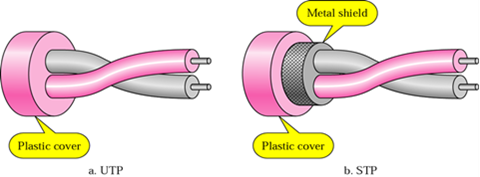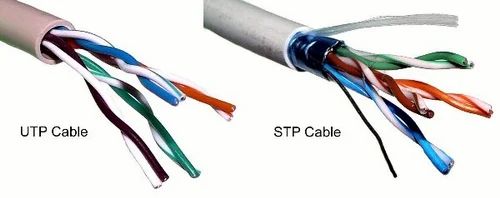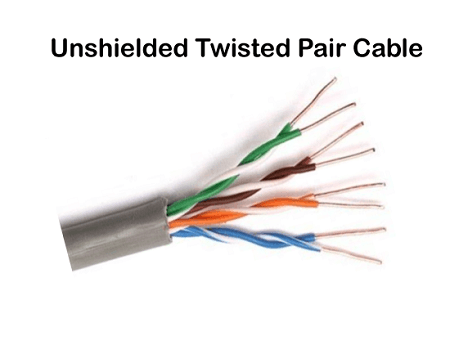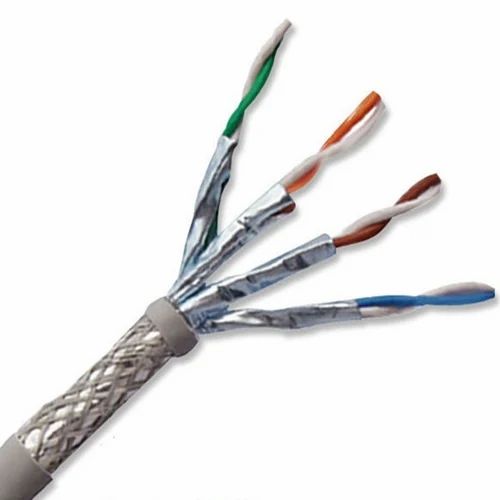STP vs UTP, Which One Is Better?
When you prepare to buy Ethernet cables, you have to choose between STP (shielded twisted pair) and UTP (unshielded twisted pair) cables. That’s really difficult to decide if you don’t have enough knowledge of these two kinds of cables. Do you want to know more? Read this article and you will find the answer.
UTP and STP are different types of twisted pair cable, where UTP cable is an unshielded twisted pair cable type, however, STP cable is shielded, they are designed and manufactured in different ways. The UTP and STP cables are used in transmitting information across distances.

What is UTP Cable?
The unshielded twisted-pair (UTP) cable is the most commonly used telecommunication medium type today, it is composed of color-coded copper in a twisted configuration. The unshielded twisted pair cable does not include any foil or braid as an insulator to avoid interference. The pairs are twisted in the cable so that the UTP patch cable can reduce interference from nearby pairs and other electrical devices.

Offices and homes are the main applications of unshielded twisted pair cable cause there is little interference or crosstalk, the UTP cable price is lower than STP cables, so it is very suitable to deploy an unshielded twisted pair cabling system in a low interference or crosstalk environment to save your cost. When you use UTP cable wiring in strong magnetic fields, it will slow down the network speed or cause network failure. Therefore, you should know the deployed environment in advance before deploying the UTP cable wiring to ensure it works well. Unshielded twisted pair cable is easy to install and STP twisted pair cable is difficult to install because the cable is larger, heavier, and harder.
There are three common UTP cable types. CAT5e: CAT5e contains four twisted pairs. It supports a maximum transmission rate of 1 Gbps, 100 MHz bandwidth for 100 meters. CAT6: CAT6 UTP cable contains four tightly wound twisted pairs. It supports a maximum transmission rate of 1 Gbps, 250 MHz bandwidth, for up to 100 meters and 10 Gbps for up to 55 meters. CAT6A: Up to 10Gbps speed, 500 MHz bandwidth, 100 meters distance.
Advantages of UTP Cables
First, easier to install and maintain. UTP cables contain no shields and they are thinner than STP cables, which is easier for cable installation and maintenance, particularly in limited space. While the shields of STP cables are quite fragile and rigid. If the shield suffered damage, cabling systems are likely to be affected by interference. What’s worse, it’s not easy to be repaired and needs special handling.
Second, more flexible. UTP cables are comparatively lighter. On one side, it makes the installation, transport and maintenance work easier. On the other side, it makes UTP cables more suitable to be used in narrow space.
Third, fewer cost. UTP cables are cheaper than STP cables. So are the related hardware. Besides, as mentioned above, UTP cables are easy to install and maintain. You don’t have to spend too much money on maintenance since UTP cables don’t rely on an outer shield. So they are beneficial to save you investment on installation and maintenance.
Applications
Due to different characteristics, the two types of cables are used in different environment.
STP cables are often used in situations nearby equipment causing EMI. For example, airports, medical centers and factories have lots of machines that can produce interference, so STP cables are typically applied. STP cables are also useful when cables must be run next to fluorescent lights, microwave ovens or powerful motors. What’s more, STP cables can be used in outdoor settings. Some people connect outdoor surveillance cameras to STP wiring. In that way, the video feed can avoid the interference generated by vehicles and power lines. And it can stop criminals from using jammers to interrupt communications between cameras and indoor monitors or recording equipment.
UTP cables are suitable to be used in offices and homes. They are less expensive than STP cables. So if the interference or crosstalk is not your main concern, you are suggested to choose UTP cables for saving you cabling cost. Remember not to select UTP cables if your place is full of powerful magnetic fields which can slow down the network speed or cause the network failure. Therefore, you’d better carefully evaluate the potential sources of interference.
What is STP Cable?
STP stands for Shielded Twisted Pair, There is copper tape inside the shielded twisted pair cable, a layer of conducting polymer or a braid mostly made of copper, and extra foil wrapping. These shielding measures inside the STP cable prevent electromagnetic interference from leaking out of or into the cable. The shielded twisted pair can dispel inductance and capacitive coupling, the inductive coupling is canceled out by Twisting, and the capacitive coupling is eliminated by the shield.
STP twisted pair cable cables are very suitable for deployment in places near equipment that may cause EMI (Electro-Magnetic Interference), such as airports and medical centers, where are many places where interference will occur. Another case is that strong electromagnetic interference will also occur near high-power machines such as microwave ovens. Shielded twisted pair cable can also work well in outdoor conditions, when shielded twisted pair is deployed in the outdoor monitoring system, the monitoring camera won't be disturbed by electromagnetic interference, which can avoid criminals from using jammers to affect the operation of the monitoring system.
Advantages of STP Cables
First, the shield of STP cables can reduce EMI. It’s good for increasing data transmission quality in buildings containing microwave equipment, HVAC (Heating Ventilation Air Conditioning) systems or radio transmitters. It blocks interference generated from devices such as power tools and vacuum cleaners. Although UTP cables are still able to reduce interference, their performance is not as good as STP cables.
Second, STP cables can reduce crosstalk with proper installation and maintenance. STP cables can resist signals from passing through the outer coating and entering nearby wires by accident because of the special cable constructure. STP cables are quite necessary for dealing with crosstalk especially when your building contains numerous network devices.
Conclusion
Choosing the right type of twisted pair cable can improve your network performance and prolong the service life of the equipment. After reading this article, I believe that you already know the difference between UTP and STP twisted pair cable cables and how to choose the right type of twisted pair cable.
When there is no strong electromagnetic environment, you can choose unshielded twisted pair cables, and the UTP patch cable price is friendly to a tight budget. When you need to avoid being disturbed by electromagnetic interference, you must consider using more expensive STP cables, which can also be operated under outdoor conditions.



